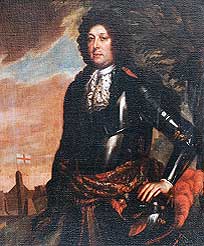Lieutenant General Piercy Kirke (The Elder)
1682-1691
1st Tangiers Regiment 1686, The Queen Dowager's Regiment
 The name of Kirke appears twice in the records of Colonelcy in The
Queen’s Royal Regiment, they being father and son.
The name of Kirke appears twice in the records of Colonelcy in The
Queen’s Royal Regiment, they being father and son.
Piercy Kirke (the elder) was born in 1646 and was appointed an Ensign in Captain Bromley’s Company in the Lord Admiral’s Regiment on 10th July 1666. Brother-in-Law of Lord Oxford, he transferred as a Cornet to the latter’s Regiment of Horse, The Blues, on 9th September 1670.
Ten years later, on 13th July 1680, he was appointed Lieutenant Colonel in the Earl of Plymouth’s 2nd Tangier Regiment, becoming the Acting Governor of Tangier in May 1681. He was promoted Governor of Tangier and Colonel of the 1st Tangier or Governor’s Regiment (later the 2nd or Queen’s) on 19th April 1682. Further promotions followed, Brigadier General 1685, Major General 1688 and Lieutenant General 1690.
In his earlier career he had been present with the Duke of Monmouth’s Regiment, in the pay of France, at the siege of Maestricht in 1673 and afterwards he served in two campaigns under Turenne. He embarked for Tangier in November 1680 and remained there until 1684 when he supervised the evacuation, which he achieved without loss, before returning to England with the Regiment in the same year.
He was subsequently to command the Regiment at Sedgemoor where, then nicknamed “Kirke’s Lambs” after their badge, they took part in the final suppression of Monmouth’s revolt. They further gained lasting infamy for their supposed part in rounding up rebels for the dreaded “bloody assize”. In fact the Queen’s had left the west for Kingston-upon-Thames before Judge Jeffries even began his circuit. The assize duty was the work of the Second Tangier Regiment, or Queen Consorts (later the 4th King’s Own). See below "Righting a Wrong"
Kirke next appears at the Siege of Londonderry, in April 1689. Under his direction the Pretender’s troops were forced to lift the siege. Kirke and the Queen’s were also in the forefront of the Battle of the Boyne. From then until January 1692 the Regiment remained in Ireland, although in September 1691, Kirke himself left for Holland to take a new command.
He died on the 20th October 1691 at Breda, and was succeeded as Colonel of the Queen’s by Colonel William Selwyn.
Righting a Wrong
Colonel Piercy Kirke took over command of the 2nd Foot (Queen's Royal Regiment) in Tangier on 19 April 1682, brought them home when the garrison was evacuated, was still in command at Sedgemoor, the last battle fought on English soil, to put down the Duke of Monmouth's Rebellion (1685) and raised the siege of Londonderry in 1689. His son, also named Piercy, was born in 1684 and subsequently commanded the Regiment for 30 years, from 1711 until 1741.
The entry against Piercy Kirke in Chambers Biographical Dictionary states:
"English Army colonel who had served 1681-84 in Tangiers, and whose men ('Kirke's Lambs') committed after Sedgmoor (1685) fearful atrocities."
The Regiment was nicknamed Kirke's Lambs because Kirke commanded it and it's badge was the Paschal Lamb. It is generally believed that the Regiment escorted the notorious Judge Jeffreys on the circuit of the Bloody Assizes, but contemporary records show that it had moved to Kingston-on-Thames before Judge Jeffreys was arrived in the West Country. The Regiment that escorted Judge Jeffreys was The Queen Consort's Regiment (4th King's Own), and the confusion may have arisen because both Regiments were at one time Tangier Regiments. Kirke was extremely popular, especially with his men, and it is also recorded that when he and The Queen's raised the siege of Londonderry "the people of Taunton devoted an evening to the drinking of his health in public, the expelces of which may now be seen in an old church book." (Savage).
(Notes on the Kirkes, father and son extracted from the Army Historical Society) |
The family are of Scottish origin and seem to have obtained their coat-of-arms c. 1600. These arms, were certainly confirmed to Piercy's father George (a groom of the bedchamber and Master of the Robes to Charles I) in 1633, with the addition of a crest and motto. (Described fully by Chester in his Harleian Society volume of the registers of Westminster Abbey, p. 295n. 1; a rough draft with drawing is in the British Library Stowe M.S. 677, f. 59). The arms can be seen on the monument to Piercy Kirke's son, Piercy Kirke the Younger, in Westminster Abbey. In 1680 Piercy Kirke was commissioned Lieutenant-Colonel of the of the Earl of Plymouth's Regiment (13 July) then raising for the reinforcement of Tangier. This was the Second Tangier Regiment (later King's/4th Foot) and Kirke sailed with them, arriving at the end of the year. Plymouth died at Tangier in 1680 and Kirke was made colonel in his place (27 November). When Kirke became governor of Tangier in 1682 he transferred to the colonelcy of the Governor's Regiment or Old Tangier Regiment (later Queen's/2nd Foot; the Lambs) and his commission is dated 19 April 1682. (all dates are as printed in Dalton). Kirke died on 20 October 1691 according to a petition to the Commons by his widow, Lady Mary, on 2 March 1703/4; this concerns outstanding pay (Commons Journals, vol XIV, p. 365). The D.N.B. prints 31 October, which is presumably the new style date. |
Lieutenant General Piercy Kirke (The Younger) »
« Previous ![]() Back to list
Back to list ![]() Next »
Next »
